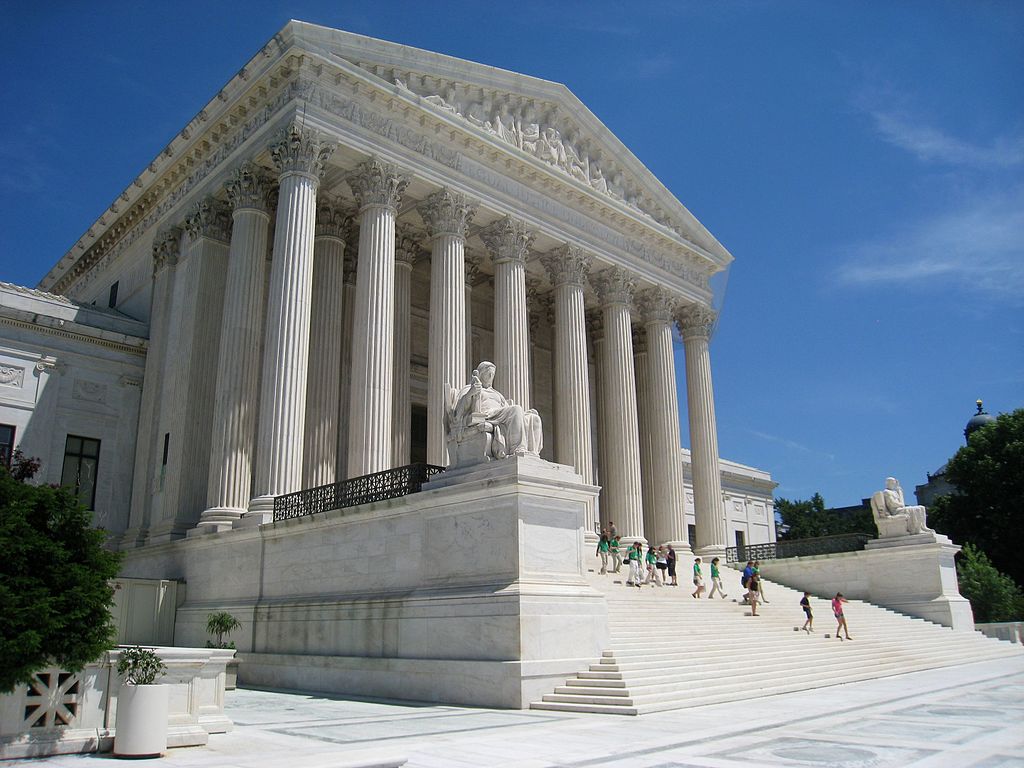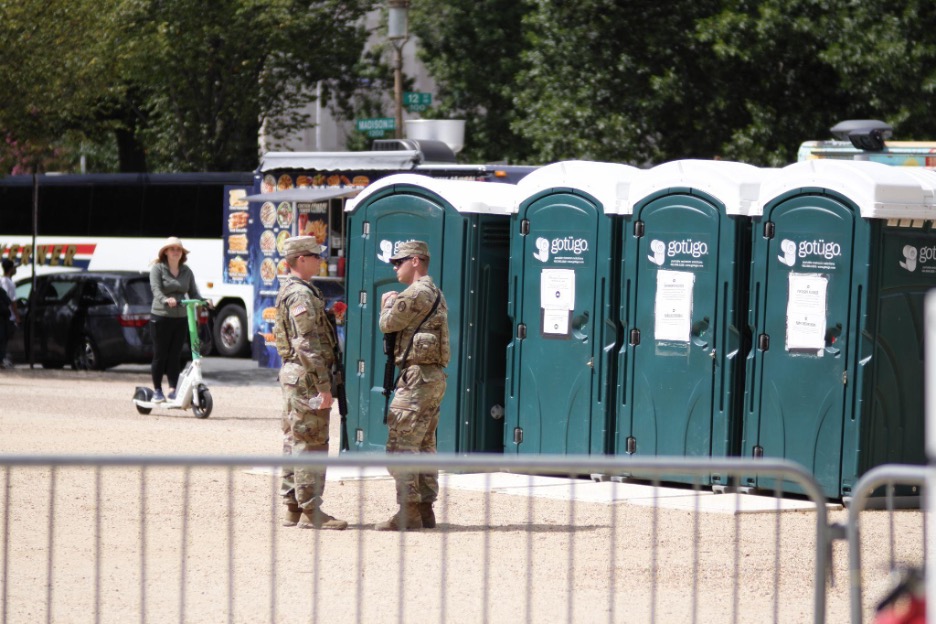A Constitutional Safety Valve for Effective Universal Relief
The Supreme Court’s decision in Trump v. CASA identified three possible routes to obtaining nationwide injunctions. The Constitution preserves a fourth.

Published by The Lawfare Institute
in Cooperation With

On June 27, the Supreme Court curtailed the availability of universal, or “nationwide,” injunctions in Trump v. CASA. It explicitly left open three avenues to obtain broad relief, but the Court did not mention another path, one the Constitution itself preserves: lawsuits filed by states directly in the Supreme Court.
Such suits would provide a safety valve to ensure that the federal government cannot strategically insulate unconstitutional activity by declining to appeal losses. They might also provide a fast track to effectively halt patently unlawful federal actions, like President Trump’s birthright citizenship executive order, even in cases where actual universal relief is not available.
Universal Injunctions and the Court’s Decision in CASA
“Universal injunction” is a phrase of art, but it generally refers to court orders that provide relief to parties and nonparties alike. When President Trump issued his birthright citizenship executive order declaring that federal agencies would no longer recognize the citizenship of certain individuals born in the United States, multiple courts entered universal injunctions, halting the executive order’s application to the parties who brought suit and to everyone else.
The Supreme Court’s decision in CASA put a stop to universal injunctions, as such. It held that the Judiciary Act of 1789—the vesting legislation that grants federal courts the general power to issue injunctions—does not include the power to award relief to nonparties. Instead, federal courts may generally provide complete relief to the parties before them and no more. That will sometimes effectuate universal relief (because many court orders necessarily protect other parties); but it will often not.
The Court provided an example to illustrate the point. If a noisy neighbor refuses to turn down their music and one plaintiff sues the noisy neighbor, a court may issue an injunction requiring the noisy neighbor to turn off the music. The injunction will serve all the neighbors, even though it was issued to provide relief only to the plaintiff. But if the noisy neighbor ignores the order and someone other than the plaintiff wants relief, they must bring their own, separate suit.
The reduced availability of universal relief raises serious concerns. What happens when Congress enacts obviously unconstitutional legislation or the president issues obviously unconstitutional executive orders? Must every single affected American participate in litigation to protect their rights? And must the country wait years for a nationally uniform answer? Thankfully, the Court stopped short of holding as much. Through some set of mechanisms—as Justice Brett Kavanaugh noted in his concurrence—the Court will necessarily continue to be called upon to issue nationwide relief early in “major” cases.
Remaining Pathways to Relief
The Court acknowledged three paths by which courts might continue to issue broad injunctions.
First, states may be able to obtain nationwide injunctions by filing suit in federal district courts, if they can demonstrate that a “patchwork” of individual injunctions is insufficient to protect state interests. Note that this first avenue does not contemplate states asserting third-party standing—allowing a third party to bring a lawsuit in support of a person or group not directly involved in the case—to raise claims on behalf of their residents. Instead, the majority opinion contemplates that states may be able to obtain universal injunctions, if they can demonstrate that a universal injunction is necessary to provide “complete relief” for injuries to the states themselves. In the birthright citizenship context, for example, the states contended that a patchwork of injunctions would be unworkable and costly, because it would require states to track and verify the immigration status of the parents of every child, along with the birth state of every child for whom states provide certain federally funded benefits. The Court directed the lower courts to assess whether a universal injunction is necessary to provide states complete relief.
Second, private parties may bring broad class actions to obtain statewide and possibly nationwide relief. Class actions are specifically authorized by the Federal Rules of Civil Procedure and allow courts to resolve claims en masse. Before a litigant can obtain broad relief via a class action, they must ask the court to “certify” a class, which requires the litigant to make four showings, referred to as numerosity, commonality, typicality, and adequacy of representation. A lead plaintiff must show that there exists a sufficiently large group of individuals or entities with claims involving nearly identical legal or factual issues, such that formally joining every possible plaintiff is impracticable; and the lead plaintiff must demonstrate that their own claims are sufficiently typical of those of the putative class and that the lead plaintiff’s counsel is competent to represent everyone. The Court’s decision in CASA acknowledged and left open the possibility that plaintiffs may be able to certify nationwide classes for some claims.
Third, the CASA decision recognized that the Administrative Procedure Act (APA), which authorizes review of actions by federal agencies, may separately empower courts to broadly set aside unlawful agency action. Enacted nearly 150 years after the Judiciary Act of 1789, the APA authorizes federal courts to review the actions of federal administrative agencies and, where appropriate, to compel agency action and to “hold unlawful and set aside” unlawful actions. In CASA, the Court dropped a footnote expressly reserving judgment on “the distinct question whether the Administrative Procedure Act authorizes federal courts to vacate federal agency action” writ large.
The Constitution itself, however, contemplates a fourth path. Article III vests the Supreme Court with both original and appellate jurisdiction. Most of what the Court does is appellate work—it hears appeals from decisions issued by lower federal courts and state supreme courts. But Article III of the Constitution also vests the Supreme Court with original jurisdiction over cases in which states are parties. Under its original jurisdiction, states may file suit directly in the Supreme Court, rather than starting at a lower court. By statute, Congress provides that this jurisdiction includes “[a]ll controversies between the United States and a State.”
Typically, the Court’s original jurisdiction cases involve disputes between one state and another state over water rights and boundary disputes. In Florida v. Georgia, for example, Florida sued Georgia directly in the Supreme Court, claiming Georgia was consuming more than its equitable share of water from the Flint River. But the Court has also entertained state lawsuits challenging federal laws.
Consider South Carolina v. Katzenbach. On Aug. 6, 1965, President Lyndon B. Johnson signed the Voting Rights Act of 1965, which, among other things, displaced voter literacy tests. In September 1965, South Carolina filed a complaint directly in the Supreme Court to challenge the act and request an injunction before the next election. The Court held that it had original jurisdiction over the action under Article III and issued an expedited decision on March 7, 1966, rejecting South Carolina’s claims. Notably, South Carolina’s theory of jurisdiction in Katzenbach—accepted by the Court—was premised on the fact that South Carolina sued then-Attorney General Nicholas Katzenbach, who was a citizen of another state, and the case was framed as one between a state and a citizen of another state. But the Court has held that it “may exercise original jurisdiction in all such cases ‘in which a state shall be party’ without excluding those in which the United States may be the opposite party,” and that remains true regardless of “whether the state is party plaintiff or party defendant.” Thus, the Court has entertained suits filed by a state against the United States under its original jurisdiction both where a state sued the United States directly and where a state brought the equivalent of an officer suit, nominally suing a high-ranking federal official but where the United States itself was “the real party in interest adverse to the state.”
The Utility of Original Jurisdiction
State suits filed under the Supreme Court’s original jurisdiction may solve two serious problems created by the Court’s ruling in CASA.
First, and most important, state suits would solve the strategic loser problem. At oral argument in the birthright citizenship case, Justice Elena Kagan laid bare the issue: If the federal government takes action so patently unconstitutional that it loses every case in the lower courts, what incentive would the federal government have to appeal to the Supreme Court? In that scenario, the federal government could insulate its actions from Supreme Court review—and universal relief—by never opting to appeal, thereby leaving the unconstitutional action in place for all of those not captured by lower-court litigation.
The Court’s decision in CASA offered cold comfort. In a footnote, the majority dismissed this concern in the birthright citizenship context because the solicitor general promised he would appeal losses on the merits. That promise, however, is not enforceable. In the event that the federal government attempts to evade Supreme Court review, state suits filed directly in the Supreme Court would short-circuit the strategic loser problem, providing a safety valve to unlock Supreme Court review.
Second, and relatedly, state suits filed directly in the Supreme Court could provide a direct path to effective universal relief, even in cases where actual universal relief is not available. Suppose that on remand in the birthright citizenship case, lower federal courts—or the Supreme Court down the road—were to hold that states have not established that they need more than a patchwork of injunctions, that nationwide class actions are not available because the birthright citizenship order impacts different individuals differently, and that relief under the Administrative Procedure Act is narrower than it appears. (None of this is likely, and one federal district court has already preliminarily certified a nationwide class and enjoined the birthright citizenship executive order.) But in that world, a state could file suit directly in the Supreme Court seeking an injunction solely for itself. A Supreme Court decision resolving the case would effectively foreclose contrary outcomes in the lower courts; and it should lead the executive branch to follow the ruling everywhere, practically affording a kind of universal relief otherwise unavailable.
Limitations
The ability of states to sue directly in the Supreme Court will not fill the entire gap left by the decision in CASA, nor should it. That is so for several reasons.
First, states typically cannot stand in for their citizens simply to assert citizens’ own rights against the federal government. Instead, states must assert their own interests. Exactly what kinds of interests suffice is unclear, with the Court itself acknowledging that its decisions on this point are “hard to reconcile.” The Court has previously suggested that these interests include a state’s sovereign interests (such as the power to create and enforce a legal code), a state’s “quasi-sovereign interest” in the well-being of its populace at large, and a state’s proprietary interests. And the Court recently confirmed that, “[t]o be sure, States sometimes have standing to sue the United States or an executive agency or officer,” citing its decision in New York v. United States, an anti-commandeering case.
But in the very same decision, the Court suggested that state standing may be more cabined than previously believed, suggesting, for example, that states may not have standing to sue over federal policies when the injury they claim is merely indirect effects on state revenues or state spending. Adding to the confusion, in CASA, Justice Samuel Alito published a concurrence that Justice Clarence Thomas joined, indicating that both believe states will need to satisfy traditional third-party standing requirements in order to obtain an injunction that benefits their residents. That would require states to establish that there is some hindrance to residents’ own ability to bring suit, introducing a new hurdle for states to surmount in order to obtain universal injunctions in cases like CASA. Where all of this nets out remains to be seen. The upshot is that, assuming states can establish sufficient sovereign, quasi-sovereign, or proprietary interests sufficient to justify a broad injunction in the birthright citizenship cases, such cases may increasingly be outliers going forward. But, as noted above, even a narrow injunction from the Supreme Court—i.e., one that grants relief only to states and not its residents—should help protect residents, foreclosing lower courts from denying them relief for the same unconstitutional action.
Second, the Supreme Court has held that its original jurisdiction over cases in which a state is a party is not mandatory, meaning the Court can simply decline to entertain a case filed by a state. Thus, in January, the Court simply declined to take up a suit filed by Utah against the United States. As Professor Steve Vladeck has explained, Justices Thomas and Alito disagree on this point, but only with respect to suits between states—because Congress has made the Supreme Court’s jurisdiction exclusive in cases between states, Thomas and Alito contend the Supreme Court must exercise review in those cases.
Third, the Supreme Court’s original jurisdiction docket can move quite slowly. When the Court does take up a case under its original jurisdiction, it often appoints a special master to oversee discovery and evidentiary proceedings and then issue a report, which the parties may contest. So while the Court has at times moved quickly as in Katzenbach, and (with thanks to Professor Vladeck for flagging) has even issued a preliminary injunction, many cases on the Court’s original jurisdiction docket take years to resolve.
Apart from these limitations, there are also prudential concerns about the strategy of states going directly to the Court. A dramatic increase in emergency litigation filed directly in the Supreme Court could lead to the Court more frequently weighing in on cases before a robust factual record is developed, potentially exacerbating some of the problems with the Court’s “shadow docket.” The Court has previously expressed related concerns, noting that the “Court is ... structured to perform as an appellate tribunal, ill-equipped for the task of factfinding, and so forced, in original cases, awkwardly to play the role of factfinder without actually presiding over the introduction of evidence.” For good reason, state suits filed under the Court’s original jurisdiction should be reserved for extraordinary circumstances, and, even then, the “wiser course” may often be for the Court to defer to lower courts in the first instance.
But when the federal government does something as dramatically unconstitutional as deny the 14th Amendment’s explicit provision for birthright citizenship, state suits filed directly in the Supreme Court may prove to be a critical safety valve. In those extraordinary circumstances, states should be able to establish harm to their own interests, giving rise to state standing. And the Supreme Court may well be inclined to intervene early, for the reasons Justice Kavanaugh articulated in his concurrence. State lawsuits filed directly in the Supreme Court may therefore play a key role in securing effective—perhaps even expeditious—relief in a post-CASA world.




.jpg?sfvrsn=8253205e_5)
